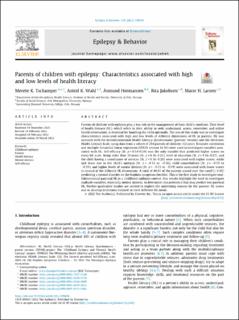| dc.contributor.author | Tschamper, Merete Kristin | |
| dc.contributor.author | Wahl, Astrid Klopstad | |
| dc.contributor.author | Hermansen, Åsmund | |
| dc.contributor.author | Jakobsen, Rita | |
| dc.contributor.author | Larsen, Marie Hamilton | |
| dc.date.accessioned | 2022-12-27T08:26:41Z | |
| dc.date.available | 2022-12-27T08:26:41Z | |
| dc.date.created | 2022-04-05T07:48:32Z | |
| dc.date.issued | 2022 | |
| dc.identifier.citation | Epilepsy & Behavior. 2022, 130 (108658), 1-8. | en_US |
| dc.identifier.issn | 1525-5050 | |
| dc.identifier.uri | https://hdl.handle.net/11250/3039492 | |
| dc.description.abstract | Parents of children with epilepsy play a key role in the management of their child’s condition. Their level of health literacy (HL), which refers to their ability to seek, understand, assess, remember, and utilize health information, is essential for handling the child optimally. The aim of this study was to investigate characteristics associated with high and low levels of different dimensions of HL in parents. HL was assessed with the multidimensional Health Literacy Questionnaire (parents’ version) and the electronic Health Literacy Scale, using data from a cohort of 254 parents of children <12 years. Bivariate correlation and multiple hierarchal linear regression (STATA version 16 SE) were used to investigate variables associated with HL. Self-efficacy (St. β = 0.14–0.34) was the only variable that predicted higher scores on every HL scale. Being older than 35 years (St. β = 0.18–0.21), level of education (St. β = 0.16–0.27), and the child having a coordinator of services (St. β = 0.16–0.28) were associated with higher scores, while sick leave due to the child’s epilepsy (St. β = −0.13 to −0.16), child comorbidities (St. β = −0.15 to −0.19), and higher levels of mental distress (St. β = −0.13 to −0.19) were associated with lower scores in several of the different HL dimensions. A total of 44.8% of the parents scored over the cutoff (≥1.85) predicting a mental disorder on the Hopkins symptom checklist. This is the first study to investigate multidimensional parental HL in a childhood epilepsy context. Our results highlight the need to investigate multiple variables, especially mental distress, to determine characteristics that may predict low parental HL. Further qualitative studies are needed to explore the underlying reasons for the parents’ HL scores and to develop inventions tailored to meet different HL needs. | en_US |
| dc.description.abstract | Parents of children with epilepsy: Characteristics associated with high and low levels of health literacy | en_US |
| dc.language.iso | eng | en_US |
| dc.rights | Navngivelse 4.0 Internasjonal | * |
| dc.rights.uri | http://creativecommons.org/licenses/by/4.0/deed.no | * |
| dc.subject | Epilepsi | en_US |
| dc.subject | Barn | en_US |
| dc.subject | Familie | en_US |
| dc.subject | Helsekompetanse | en_US |
| dc.title | Parents of children with epilepsy: Characteristics associated with high and low levels of health literacy | en_US |
| dc.title.alternative | Parents of children with epilepsy: Characteristics associated with high and low levels of health literacy | en_US |
| dc.type | Peer reviewed | en_US |
| dc.type | Journal article | en_US |
| dc.description.version | publishedVersion | en_US |
| dc.source.pagenumber | 1-8 | en_US |
| dc.source.volume | 130 | en_US |
| dc.source.journal | Epilepsy & Behavior | en_US |
| dc.source.issue | 108658 | en_US |
| dc.identifier.doi | 10.1016/j.yebeh.2022.108658 | |
| dc.identifier.cristin | 2015279 | |
| dc.relation.project | Stiftelsen Dam: 461688 | en_US |
| cristin.ispublished | true | |
| cristin.fulltext | original | |
| cristin.qualitycode | 1 | |

